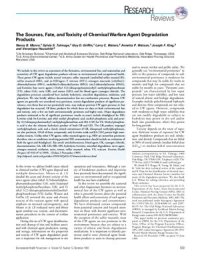
Ebook: The Sources, Fate, and Toxicity of Chemical Warfare Agent Degradation Products
- Genre: Medicine
- Tags: Медицинские дисциплины, Токсикология, Военная токсикология
- Language: English
- pdf
Статья. Опубликована в журнале Environmental Health Perspectives // 1999. - Vol. 107, № 12 - pp. 933-974
We include in this review an assessment of the formation, environmental fate, and mammalian and ecotoxicity of CW agent degradation products relevant to environmental and occupational health. These parent CW agents include several vesicants: sulfur mustards [undistilled sulfur mustard (H), sulfur mustard (HD), and an HD/agent T mixture (HT)]; nitrogen mustards [ethylbis(2-chloroethyl)amine (HN1), methylbis(2-chloroethyl)amine (HN2), tris(2-chloroethyl)amine (HN3)], and Lewisite; four nerve agents {O-ethyl S-[2-(diisopropylamino)ethyl]methylphosphonothioate (VX), tabun (GA), sarin (GB), and soman (GD)}; and the blood agent cyanogen chloride. The degradation processes considered here include hydrolysis, microbial degradation, oxidation, and photolysis. We also briefly address decontamination but not combustion processes. Because CW agents are generally not considered very persistent, certain degradation products of significant persistence, even those that are not particularly toxic, may indicate previous CW agent presence or that degradation has occurred. Of those products for which there are data on both environmental fate and toxicity, only a few are both environmentally persistent and highly toxic. Major degradation products estimated to be of significant persistence (weeks to years) include thiodiglycol for HD; Lewisite oxide for Lewisite; and ethyl methyl phosphonic acid, methyl phosphonic acid, and possibly S-(2-diisopropylaminoethyl) methylphosphonothioic acid (EA 2192) for VX. Methyl phosphonic acid is also the ultimate hydrolysis product of both GB and GD. The GB product, isopropylmethylphosphonic acid, and a closely related contaminant of GB, diisopropyl methylphosphonate, are also persistent. Of all of these compounds, only Lewisite oxide and EA 2192 possess high mammalian toxicity. Unlike other CW agents, sulfur mustard agents (e.g., HD) are somewhat persistent; therefore, sites or conditions involving potential HD contamination should include an evaluation of both the agent and thiodiglycol.
We include in this review an assessment of the formation, environmental fate, and mammalian and ecotoxicity of CW agent degradation products relevant to environmental and occupational health. These parent CW agents include several vesicants: sulfur mustards [undistilled sulfur mustard (H), sulfur mustard (HD), and an HD/agent T mixture (HT)]; nitrogen mustards [ethylbis(2-chloroethyl)amine (HN1), methylbis(2-chloroethyl)amine (HN2), tris(2-chloroethyl)amine (HN3)], and Lewisite; four nerve agents {O-ethyl S-[2-(diisopropylamino)ethyl]methylphosphonothioate (VX), tabun (GA), sarin (GB), and soman (GD)}; and the blood agent cyanogen chloride. The degradation processes considered here include hydrolysis, microbial degradation, oxidation, and photolysis. We also briefly address decontamination but not combustion processes. Because CW agents are generally not considered very persistent, certain degradation products of significant persistence, even those that are not particularly toxic, may indicate previous CW agent presence or that degradation has occurred. Of those products for which there are data on both environmental fate and toxicity, only a few are both environmentally persistent and highly toxic. Major degradation products estimated to be of significant persistence (weeks to years) include thiodiglycol for HD; Lewisite oxide for Lewisite; and ethyl methyl phosphonic acid, methyl phosphonic acid, and possibly S-(2-diisopropylaminoethyl) methylphosphonothioic acid (EA 2192) for VX. Methyl phosphonic acid is also the ultimate hydrolysis product of both GB and GD. The GB product, isopropylmethylphosphonic acid, and a closely related contaminant of GB, diisopropyl methylphosphonate, are also persistent. Of all of these compounds, only Lewisite oxide and EA 2192 possess high mammalian toxicity. Unlike other CW agents, sulfur mustard agents (e.g., HD) are somewhat persistent; therefore, sites or conditions involving potential HD contamination should include an evaluation of both the agent and thiodiglycol.
Download the book The Sources, Fate, and Toxicity of Chemical Warfare Agent Degradation Products for free or read online
Continue reading on any device:

Last viewed books
Related books
{related-news}
Comments (0)